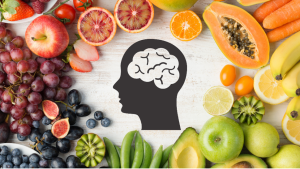Written by Cristina Guerra, COTA / L, OTS
Nutrition is often overlooked when it comes to Parkinson’s disease; however, it plays an important role in the management of the disease and disease process and should be considered just as much as all other forms of treatment, such as therapy and medications (Breasail et al., 2022). Nutrition is the taking in and use of food and other substances that are essential for growth, health and good condition. Nutrition can be broken down into three basic parts: 1) Food and/or drink is eaten/drank; 2) The body breaks down the food and drink into nutrients; 3) Nutrients (substances used by the body for growth, health and survival) travel to different parts of the body through the bloodstream and are used for energy and other purposes. Both nutrition and diet are essential for achieving and maintaining general health and well-being and nutrition should be considered when looking at disease management (National Cancer Institute, n.d.).
Parkinson’s is well-known to decrease dopamine levels in the brain. It is estimated that in individuals with Parkinson’s, at least 80% of dopamine-producing cells are lost within the brain, causing the multitude of motor symptoms that occur with the disease and can also contribute to the kinds of foods that we choose to eat. Dopamine is the “feel good” chemical in our brain that allows us to feel pleasure, motivation and satisfaction and is released at various times throughout the day, including when we accomplish or do well on/with something and eating foods that are high in fat and sugar. Dopamine also controls and plays a role in body movements and muscle control, which leads to the many physical and visible signs and symptoms that are observed in those with Parkinson’s disease (HealthDirect, 2021).
Many individuals with Parkinson’s have been observed, through various studies, to increase their consumption of sweet foods such as cookies, cakes, ice cream, etc. due to the decreased levels of dopamine in the brain. This overconsumption of sweet foods, along with decreased consumption of “healthy” foods, such as fruits, vegetables, and proteins, can lead individuals to become malnourished (Breasail et al., 2022).
Malnourishment occurs when there is an imbalance in the nutrients that our body takes in; we can consume too little good nutrients (i.e., fiber and protein) and too many bad nutrients (i.e., sugar). In various studies conducted, many individuals, more specifically those with Parkinson’s, have been found to be malnourished or at risk for being malnourished, regardless of age. Being malnourished can also affect and impact your mood and overall self-feelings. In studies conducted on individuals with Parkinson’s and the role nutrition plays in the disease process, it was found that those who were malnourished also experienced greater symptoms and feelings of anxiety and depression compared to those who were not. It is also worth noting that when those individuals changed their diets, they reported decreased feelings and symptoms of anxiety and depression overall (Ongun, 2018). Malnourishment can also cause sarcopenia, which is a loss of muscle tissue and occurs naturally throughout the aging process; however, when someone is malnourished, it accelerates the loss (Breasail et al., 2022).
Many studies have been conducted on individuals with Parkinson’s disease and their nutritional status to observe and determine if food is linked to the severity of the symptoms. In one study conducted by Ongun (2018), it was found that those with Parkinson’s who had a poor diet and poor nutritional status had a decreased overall quality of life. These individuals had higher levels of anxiety and depression compared to those in the study with better nutritional status (Ongun, 2018).
Another study conducted by Breasail et al. (2022) found that those with poorer nutritional status also had increased difficulty with successfully completing bowel movements, but also had a quicker and, at times, more significant cognitive decline and decreased energy levels throughout the day. Difficulty with successful bowel movements, constipation, has also been found to relate to decreased levels of absorption of medications, which can also play a role in the severity of both motor and non-motor symptoms (Breasail et al., 2022).
Breasail et al. (2022) also found that, not only does nutrition play a role on the nonmotor symptoms associated with Parkinson’s disease, but on the motor symptoms as well. Nutrition affects the strength of our muscles and endurance, with a poorer diet correlating to decreased muscle strength and endurance (Breasail et al., 2022). This can cause difficulty with things such as standing for longer periods of time and difficulty with grasping and maintaining that grasp on various items (i.e., utensils, toothbrush, remote control, etc.). Poor nutritional status has also been linked to decreased balance, which can increase the risk of falling (Breasail et al., 2022; Ongun, 2018). Nutritional status has also been shown to have an effect on gait and mobility, with those with a poorer nutritional status showing signs of increased impairment of gait and mobility, even after taking medications and on “good” days (Ongun, 2018). Because tremors and dyskinesia are typically managed with medications, those who choose to eat high-protein meals in the morning impact the body’s ability to absorb the medications effectively. It has been shown that eating high-protein meals for breakfast, before or after you take your medications, decreases the amount of medication that your body can effectively absorb and use, thereby decreasing the effectiveness of the medication (Baroni & Zuliani, 2014).
References
Baroni, L. & Zuliani, C. (2014). Ensuring good nutritional status in patients with Parkinson’s disease: Challenges and solutions. Journal of Parkinsonism & Restless Legs Syndrome, 4, 77-90. DOI:10.2147/JPRLS.S49186
Breasail, M. O., Smith, M. D., Tenison, E., Henderson, E. J., & Lithander, F. E. (2022). Parkinson’s disease: The nutrition perspective. The Proceedings of the Nutrition Society, 81(1), 12-26. DOI:10.1017/S0029665121003645
HealthDirect. (2021). Dopamine. https://www.healthdirect.gov.au/dopamine#:~:text=my%20dopamine%20levels%3F-,What%20is%20dopamine%3F,send%20messages%20to%20each%20other
National Cancer Institute (n.d.). Nutrition. https://www.cancer.gov/publications/dictionaries/cancer-terms/def/nutrition
Ongun, N. (2018). Does nutritional status affect Parkinson’s Disease features and quality of life? PLoS One, 13(10), 1-14. DOI:10.1371/journal.pone.0205100



